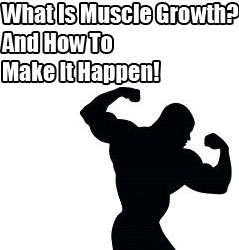 Once you understand exactly what muscle growth actually is, you’ll be in a much better position to make it happen.
Once you understand exactly what muscle growth actually is, you’ll be in a much better position to make it happen.
In order to really comprehend this, we need to take a look at the structure of muscle tissue.

The most important part of this diagram is the item labeled ‘Muscle Fiber‘ on the right.
So What Is Muscle Growth?
The simplest way to put it is that muscle hypertrophy/growth occurs when those individual muscle fibers increase in diameter i.e. get thicker.
And how do muscle fibers get thicker?
Inside the muscle fiber are movement molecules called myosin, which form cross-bridges with a protein filament called actin. The interaction between the two allow the muscle to contract and produce force.
Muscle growth occurs at this microscopic level.
Through repeated and intense muscular contractions small microtears are produced in the myosin and actin strands.
The fact that these myosin and actin strands are now torn allows them to attract the growth elements necessary for their full repair and growth.
The goal is that when the recovery/healing process is complete, we have thicker and stronger strands.
But in order to ensure that the stimulus we create in the gym is sufficient enough to produce growth, not just repair, we need to OVERLOAD the muscle.
The problem with most trainees is that they:
- Don’t train intensely enough
- Don’t track and record each workout to ensure they are making progress each and every workout.
And they are therefore not actually OVERLOADING the muscle on a consistent basis.
I don’t care if they spend 10 hours in the gym every day. If they aren’t training correctly, their body will look the same a year from now.
This post lays out the 12 steps of how to build muscle.
T.H.T. training creates the kind of microtears I’ve just talked about.
It also leaves adequate time for recovery and growth to occur. Remember, insufficient rest means you’ll never actually grow.
It generates MAXIMUM OVERLOAD in every single workout.
It also forces you to train to PROGRESSIVELY overload the muscles now and indefinitely into the future i.e. you keep progressing upwards and upwards. There are no wasted workouts; not a single workout will not stimulate increases in strength and size.
If you’ve never trained THT style, let today be the start of a new way of training which will finally bring you the results you desire. Just input your name and email.
Now you know how muscle growth occurs – you just gotta do it!
Train With Intensity!
Mark

It should be noted that there are TWO types of hypertrophy: (1) functional (Myofibrillar), and (2) non-functional (Sarcoplasmic).
Functional/Myofibrillar Hypertrophy is what Mark described above… where the muscle fibers get thicker and stronger.
Non-functional/Sarcoplasmic Hypertrophy is when you produce more fluid around the muscles… which will make them bigger & prettier, but not stronger.
Here are a few good articles about it:
https://www.bodybuilding.com/fun/hale6.htm
https://jasonferruggia.com/functional-hypertrophy-fact-vs-fiction/
Helo
nice workout
hey mark could you give me some advice on working out on an empty stomach in the morning during TSPA? is it safe ? and what should i be watching out for on the carb up during MANS? should i watch out for lactose intake?
@Jesh
I have 2 teaspoons of BCAAs every 2 hours starting when I start my workout. Lately I’ve been cutting it down to every 1.5 hours. Either way, that keeps the muscle from eating itself, is low/no calorie. And gets me ready for my big first meal, 2 hours after workout ends. Others would do or say different, but I am still gaining a couple reps every week, most of the time.
@Jesh. Have a protein shake or at least, as John has said, some BCAAs. Don’t train on an empty stomach.
Mark, here’s an observation based on my own experience.
As poundages increase, recovery time too needs to increase.
Else, no hypertrophy / progress.
In my case, I find it best to train again only on the fourth / fifth day – sometimes, depending upon the volume, even sixth / seventh day (especially for the larger muscle groups).
Intensity, of course, remains ‘highest possible’.
At a younger age, one may, perhaps, need less recovery time.
@Anand. This was an issue talked about much by the late Mike Mentzer. He believed that recovery ability never changed. So the stronger you get, the longer you have to wait between workouts for full recovery and overcompensation to occur. He would say that the bigger you get, the LESS often you should train, not more. However, intensity is always kept high. I don’t know about this. No-one knows for sure. I train with the same frequency as I always did. I seen evidence that the more trained an athlete is, the quicker they can recover. But each person can assess them for themselves without taking someone’s opinion on board. It’s all in the strength increases. If you haven’ fully recovered, you’ll be weaker. If you are making progress from workout to workout, then obviously enough time has elapsed between sessions for full recovery and growth.
Thanks Mark.